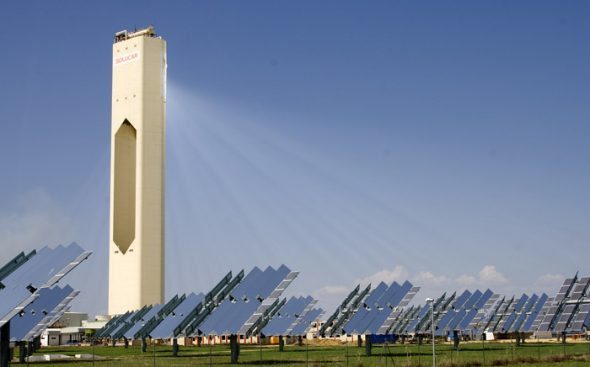Alinta Energy, the owner of the ageing brown coal generators at Port Augusta which are to be closed soon, has abandoned the idea of replacing them with a solar tower and storage power station, declaring the idea to be financially unviable.
In an updated report released on Wednesday, known as the “Final Balance of Study Report (Milestone Four Report)” Alinta says it will not proceed with Stage Two of the feasibility study co-funded by the Australian Renewable Energy Agency, effectively walking away from the idea.
The Alinta report argues that its most recent – but still highly contested – estimates of the cost of solar thermal with storage at Port Augusta are valid, and it would not deliver a return on investment.
Even on the best case scenario, according to the Alinta estimates, it would deliver an internal rate of return of 3.4 per cent a year. Alinta says it needs an IRR of at least 12 per cent a year.
Outside observers, however, were highly critical of the report, suggesting that Alinta had not factored in the use of debt, or project finance, and had based its cost estimates on 100 per cent equity in the project.
The critics say this is unrealistic, and such projects would normally use 70 per cent debt. The only people thinking of building or financing a power plant on 100 per cent equity would be a suburban homeowner, and that only for a 3kW or 5kW rooftop solar system costing around $4,000 to $8,000.
Groups lobbying for a solar thermal plant said it was no surprise that Alinta was walking away from the idea.
“Obviously we’re disappointed that Alinta are choosing to walk away, but this has been coming for a while,” said Daniel Spencer, from the Repower Port Augusta Alliance.
“Alinta have never had their heart in it. There are other companies seriously interested in making solar thermal happen in the region, and the State Government acting is critical to making it happen.”
Indeed, Alinta’s decision may not be the end of the idea. The US company SolarReserve, which is completing the first large scale solar tower plus storage project in the US, is also interested.
SolarReserve, as we reported here, is one of a number of solar thermal developers thought to have put forward proposals in the “next generation solar” auction being run by the ACT government.
It is thought that this project has come up with a different financing outcome than Alinta, and may even be based in Port Augusta. The ACT has previously signed contracts with projects in South Australia and Victoria under its wind energy option.
Spencer said there was an opportunity for the South Australia government to do the same thing as the ACT, and conduct its own auction, an idea also being pursued by the Queensland government.
“If the State Government implemented a policy to buy power from a solar thermal plant it would attract interest from companies who are serious about building solar thermal in Port Augusta” Spencer said.
“It’s critical that the State Government gets in the game to make this happen to spur new jobs. This would build on the Sundrop farms development and a proposed solar and wind farm in the region.”
Solar Reserve was not commenting on Wednesday, but its first-of-a-kind Crescent Dunes project is being built at a cost of US135/MWh, with a Department of Energy loan, while its second project at Redstone in South Africa is being built at a cost of $US122MWh, without subsidies. This is vastly different to the $201/MWh levellised cost of electricity calculated by Alinta, even with the recent fall in the $A.
Other companies have also suggested alternatives for Port Augusta, including DP Energy, which is proposing a 300MW solar PV and wind energy hybrid plant.
Alinta is scheduled to close the last of its brown coal generators in Port Augusta between early 2016 and early 2017, meaning the end of coal-fired generation in the state.
That will leave the local grid relying on wind and solar, which currently account for more than 40 per cent of demand, along with local gas-fired generators and the interconnector with Victoria.
While there is a push from nuclear lobbyists for a large nuclear powered station in the state, an idea currently being considered by the state-sponsored royal commission, this would be 15-20 years away and would require huge upgrades to the big transmission lines to the other states.
In the meantime, the Australian Energy Market Operator predicts that within 10 years, rooftop solar alone could be meeting all the state’s daytime demand on occasions, meaning that the case for base load power generation is removed, as the UK grid operator conceded last week.
That provides more emphasis on storage, both within household and business consumers, which is being encouraged by the state government and the Adelaide City Council, and at utility-scale projects, which are being pursued by a consortium led by AGL Energy.
Some communities and businesses are going off-grid altogether, as suggested by the local network operators. A new retirement village on the Eyre Peninsula is going to run entirely on renewable energy and battery storage, because it will be cheaper than being connected to the grid.
A solar thermal plant with storage at Port Augusta could play a critical role. It is strongly advocated by analysts such as Beyond Zero Emissions, and is being widely adopted in Latin America and South Africa, among others.
But Alinta CEO Jeff Dimery said in a statement that “constructing a 50MW molten salt power-tower located in Port Augusta is not commercially feasible” at this time.
“Alinta Energy, in consultation with the Australian Renewable Energy Agency (ARENA), will conclude the solar thermal feasibility study at Stage One (pre-feasibility) and not continue to Stage Two (full-feasibility). Continued investigation of full-feasibility would only serve to reinforce the findings of Stage One,” Dimery said.












